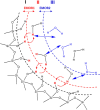Effect of Exchange Dynamics on the NMR Relaxation of Water in Porous Silica
- PMID: 39499855
- PMCID: PMC11571216
- DOI: 10.1021/acs.jpclett.4c02590
Effect of Exchange Dynamics on the NMR Relaxation of Water in Porous Silica
Abstract
The interaction of molecules, in particular, water, with solid interfaces has been studied by a multitude of methods, among them nuclear magnetic resonance spin relaxation. The frequency dependence of the relaxation times follows patterns that have been interpreted in terms of the molecular orientation and dynamics. Several different model approaches could successfully explain limiting cases of 1H relaxation dispersion in systems with rigid surfaces such as silica gel or glass, but none of them can reproduce the relaxation of both 1H and 2H nuclei, which differ in their respective relaxation mechanisms, dipolar vs quadrupolar. From detailed studies of the dynamics of hydration of water in biological materials, the importance of hydrogen and molecular exchange to the longitudinal relaxation time of T1 was demonstrated. In this work, exchange times of both H2O and D2O in hydrophilic silica gel are varied in a controlled fashion in a wide range using disodium hydrogen phosphate, and the effect of physical exchange on spin relaxation is quantified for the first time in such systems using the exchange-mediated reorientation model.
Conflict of interest statement
The authors declare no competing financial interest.
Figures


Similar articles
-
Multiscale nuclear magnetic relaxation dispersion of complex liquids in bulk and confinement.Prog Nucl Magn Reson Spectrosc. 2018 Feb;104:12-55. doi: 10.1016/j.pnmrs.2017.11.001. Epub 2017 Nov 10. Prog Nucl Magn Reson Spectrosc. 2018. PMID: 29405980 Review.
-
Self-diffusion studies by intra- and inter-molecular spin-lattice relaxometry using field-cycling: Liquids, plastic crystals, porous media, and polymer segments.Prog Nucl Magn Reson Spectrosc. 2017 Aug;101:18-50. doi: 10.1016/j.pnmrs.2017.04.001. Epub 2017 Apr 9. Prog Nucl Magn Reson Spectrosc. 2017. PMID: 28844220 Review.
-
31P NMR probes of chemical dynamics: paramagnetic relaxation enhancement of the (1)H and (31)P NMR resonances of methyl phosphite and methylethyl phosphate anions by selected metal complexes.Inorg Chem. 2001 Dec 17;40(26):6547-54. doi: 10.1021/ic010728w. Inorg Chem. 2001. PMID: 11735462
-
Molecular exchange dynamics in partially filled microscale and nanoscale pores of silica glasses studied by field-cycling nuclear magnetic resonance relaxometry.J Chem Phys. 2004 Dec 1;121(21):10648-56. doi: 10.1063/1.1808423. J Chem Phys. 2004. PMID: 15549948
-
Nuclear magnetic relaxation induced by exchange-mediated orientational randomization: longitudinal relaxation dispersion for spin I = 1.J Chem Phys. 2012 Aug 7;137(5):054503. doi: 10.1063/1.4739297. J Chem Phys. 2012. PMID: 22894360
References
-
- Debenedetti P. G. Supercooled and glassy water. J. Phys.: Condens. Matter 2003, 15 (45), R1669–R1726. 10.1088/0953-8984/15/45/R01. - DOI
-
- Bernal J. D.; Fowler R. H. A Theory of Water and Ionic Solution, with Particular Reference to Hydrogen and Hydroxyl Ions. J. Chem. Phys. 1933, 1 (8), 515–548. 10.1063/1.1749327. - DOI
-
- Bronsted J. N. Acid and Basic Catalysis. Chem. Rev. 1928, 5 (3), 231–338. 10.1021/cr60019a001. - DOI
-
- Katko T. S.; Juuti P. S.; Vuorinen H. S. History of water and health from ancient civilizations to modern times. Water Supply 2007, 7 (1), 49–57. 10.2166/ws.2007.006. - DOI
-
- Juuti P. S.; Katko T. S.; Vuorinen H. S.. Environmental History of Water: Global Views on Community Water Supply and Sanitation; Iwa Pub, 2007.
LinkOut - more resources
Full Text Sources

